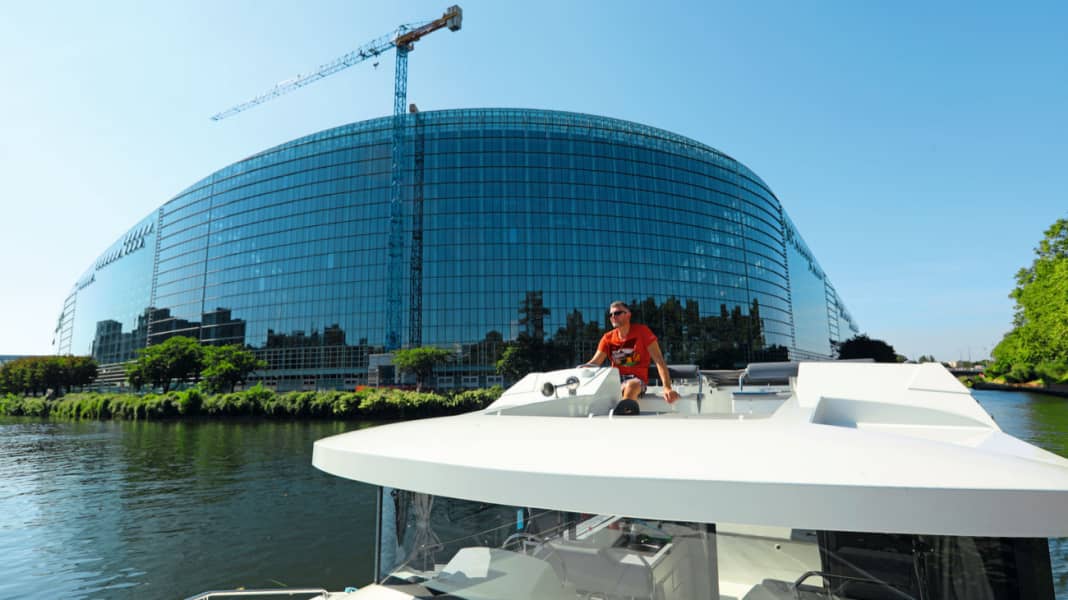
There are no locks waiting for us on the first stretch. But we will have plenty of them on our journey through Alsace to Strasbourg, where the Rhine-Marne Canal ends. We will be travelling for a week, through the northern Vosges mountains and the Rhenish lowlands to this metropolis in the heart of Europe. But we are still a long way from the Rhine: from our early start in Hesse, at the le Boat charter base, the Canal de la Marne au Rhin, as it is called in French, winds its way through fields and small villages with beautiful names such as Schneckenbusch. The valley soon narrows and leads to the first of the two canal tunnels that await us today. The traffic lights in Niderviller show green, maximum speed: four kilometres per hour. It's 475 metres through the mountain, with lights on the walls and ceiling providing illumination. But it's cold and damp, our breath is condensing. With the towpath on the right, the walled semicircle leads back into the glistening sunlight. The second tunnel at Arzviller, 2305 metres long, is only two bends away. But this time we have to wait for oncoming traffic, together with three other boats. Passing ships have immortalised themselves on the wall at the water's edge; witnesses to a time when freight was still transported here. Then it's our turn; a distance of fifty metres is mandatory.
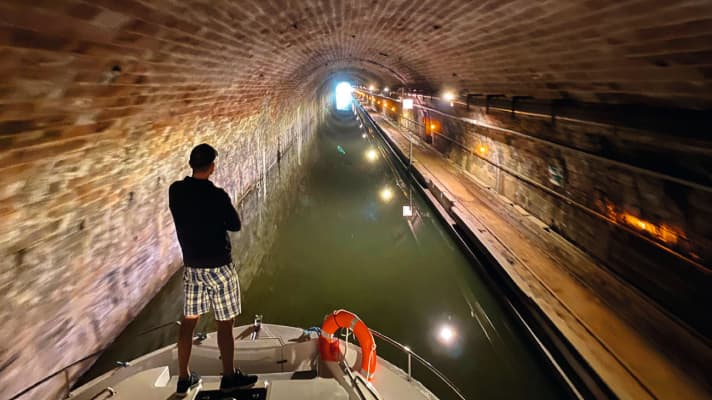
We are still talking about how ventilation is provided in this canyon when turbines start up in front of us with a deafening noise - and a headwind! Outside, the route continues close to the rock, the canal has been blasted into the slope. To the left below us, behind tall fir and spruce trees, lies the old lock staircase. It took a whole day to climb its seventeen chambers back then. Today, fortunately, the descent is quicker: We have reached the upper outer harbour of the Saint-Louis/Arzviller lift, which compensates for the height difference of almost fifty metres with an inclined plane - a clever design. After the lift gate of the entrance has lowered behind us, the filled trough glides downhill on its guide rails as if weightless, while the two massive counterweights glide upwards. The difference in weight is regulated by the amount of water in the trough and is so minimal that two 120 hp motors are sufficient to drive it. The journey takes five minutes. At the bottom, we moor on the bank to have an early start. The sun is blazing. Fortunately, we are in the shade, so the butter is not in such a hurry to melt.
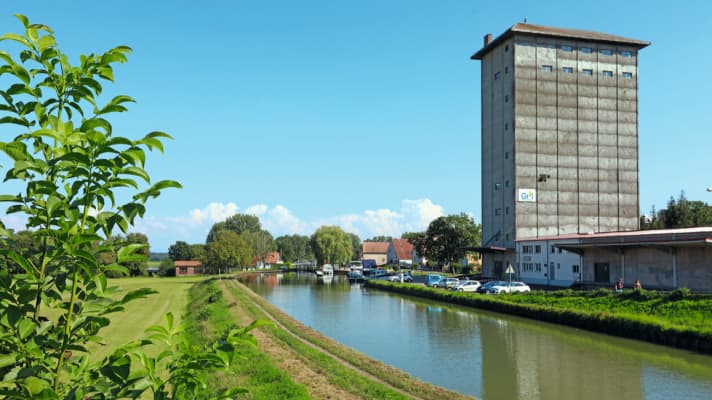
It's time for our first lock, number 18: cautious entry, lines fore and aft.Levez! The blue rod of the onward transfer switch is pushed upwards against the contact and the upper gate begins to close with a red flashing light and signal tone before it descends 2.50 metres. This is the (semi-automatic) routine for the next few days to Strasbourg. At 3 p.m. we pass Lutzelbourg with its imposing red sandstone castle ruins high above the village. We will stop here on the way back and climb up. Lock 21 also marks the start of our first "chain": a series of successive locks are operated in such a way that the waiting times for passage are minimised. However, there is still no sign of a green wave. Instead, we continue through the wooded valleys towards Saverne. Doubts arise as to whether we will make it to the closing time at 7 pm, but in the end it's enough. Just through lock 30/31, which is twice as high, and we've reached our destination. We moor with the stern between other boats in the Port de Plaisance. Our bow points directly at Europe's longest neo-classical castle façade, the Château des Rohan. The harbour is rocking, we've stumbled into a music festival! On the flybridge, we enjoy tarte flambée and Meteor, the local beer, before heading to Place Charles de Gaulle. The castle is already in darkness, but the night is burning outside: wooden tables and benches on the pavement, street food and a large stage with a wild lighting system. The whole of Saverne is celebrating and we are right in the middle of it.
At around 10 a.m., we are almost the last to cast off. The next chain of locks is waiting for us right at the end of the town.Tirez!Pull the rope switch that hangs in the middle of the water in front of it. Lock 32 is the start. We are out of the Vosges mountains in one go, but not yet out of their hilly foothills. The canal now has longer, straighter sections through meadows, pastures and fields of sunflowers and corn. Storks lie in wait for prey. Small woods and trees on either side provide precious shade, while church spires pass near and far. Anyone with a bike seems to be out and about, amateur teams training, whole families and couples picnicking. After Écluse No. 36, the first chain of locks ends, time for a break: behind us, the Vosges Mountains loom on the horizon as nothing more than a blue silhouette. We moor with pegs in a wide bend, then the bimini top is put up. Pâté Lorrain: firm puff pastry with a filling of minced veal and pork. A mighty meal!

After the manageable industrial area of Dettwiller, lock chain number two begins on this day. We have long known exactly which line goes on which bollard - if there is one. So the afternoon takes its course, always in time with the locks. The rare longer sections without a barrage are just a few kilometres long, but the bridges ensure that we have to fold up our parasol again and again. Our destination for today is Waltenheim-sur-Zorn. We now also pass the possible harbours for the return journey in this corner, first below Hochfelden, then at Schwindratzheim. Both are disappointments, simple recesses on the shore with minimal infrastructure. In both cases, most of the space is taken up by péniches that have been converted into residential vessels.
Another chain of locks! But we soon leave the twelfth and last chamber of the day with No. 43. To starboard, the hills close in again, and after a final loop, the large silo at Waltenheim comes into view ahead. We approach the pier alongside almost in its shadow. Everything here is new and pretty, mooring fees and electricity can be paid at the pillar - perfect. René climbs the high plateau above on his bike and explores the village of Mommenheim opposite. He comes back with the information that there will be no cordon bleu today, the only restaurant, the Ancre, is closed. But he finds what he's looking for in the neighbouring village: Vintage Burger is a hit, a mix of cellar bar and Route 66, with miniature trucks, leopard high heels and the King as a shiny bust on the counter. Served with Budweiser, Brooklyn Lager and Johnny Cash.
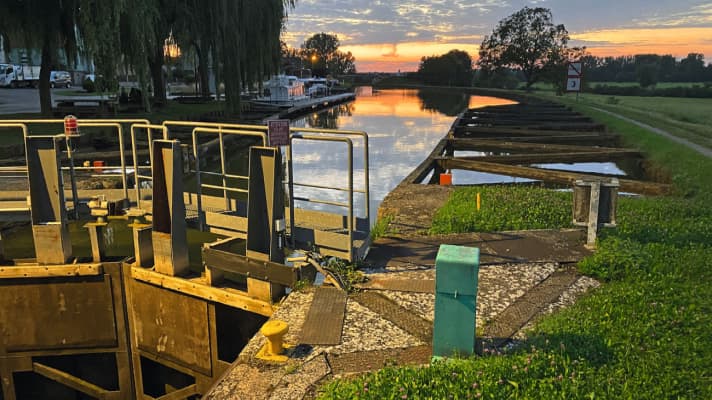
As we moored in the middle of the lock chain yesterday, we now have to register again at the intercom:"Bonjour, nous sommes à Waltenheim et nous voulons passer l'écluse no. 44 en direction de Strasbourg, s'il vous plait." The signal immediately switches to red-green. The Rhine plain now lies ahead of us. The land becomes flat and expansive; despite the slight gradient, you can already see far to the north and east from the headwaters of the barrages, where the Black Forest stretches across the horizon. Urbanity also increases with more roads, the motorway route in the background, more railway lines, bridges and high-voltage power lines. The waterway now runs as if drawn with a ruler, although it is still interrupted by locks. The routine quickly returns. It is the most monotonous section. After two and a half hours, we take another break in the shade of the riverside trees near Vendenheim.
Finally, our Horizon reaches the outer suburbs of Strasbourg. Multi-storey blocks of flats, detached houses and apartment blocks. In fact, it's all very reminiscent of Germany; the geographical and cultural proximity is obviously not to be underestimated. The canal leads straight through to the last lock on the outward journey, number 51, and then goes clockwise around the centre (the waterways inside are closed or not navigable). We pass the political centre of Strasbourg, first the imposing curved glass façade of the European Parliament on the starboard side, then the Court of Human Rights and the Council of Europe on the port side. A bit like the Spreebogen in Berlin's government district. The heart of power, here and there. We leave the last, much larger lock of the canal to the Rhine harbour on our left. Instead, as planned, we turn south into the Bassin des Remparts, which was once part of the fortifications of the often embattled city and today, in addition to a few loading bays, mainly harbours residential ships - and the Port de Plaisance in front of the trees of the Parc de la Citadelle. We head back to the jetty, through so much greenery that I'm not entirely comfortable with the cooling water and thrusters. But for now we are here - and Strasbourg lies ahead of us!
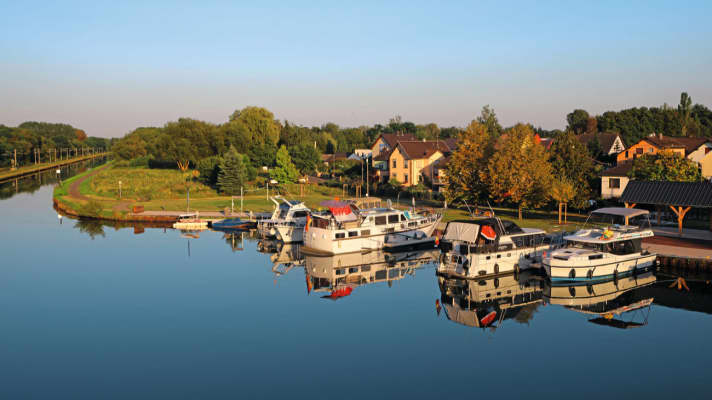
We've only been travelling for three days, but we've already experienced so much that it almost feels like a week. René wants to set off on his bike, I take advantage of the hour to take some photos. Later, we have an appointment in front of the famous cathedral. The route there leads through the park. Although it's easy to see on the map, it completely blocks out the city around it. An oasis of calm Even here you can see many students. No wonder, the university quarter begins behind the prefabricated buildings on the Place de l'Esplanade. Lots of concrete from the seventies, but an open area with modern corners. Either way, on a day like this, Strasbourg seems like a fantastic place to study. Pubs, bars and restaurants are open, there are tables on the pavement everywhere and almost all of them are occupied. The atmosphere seems fantastic and corona is once again far away. The controls here are much stricter than in Germany, nothing works without a licencepass sanitaire. What is also noticeable: a lot of German in the townscape, not only on the bilingual street signs. The first half-timbered houses line the road, which soon meets the banks of the River Ill. Although the river is navigable, it is not authorised for general traffic. Flower boxes bloom everywhere. The path leads along the Quai des Bateliers and the tower of the cathedral rises above the roofs of the old town island, behind the Palais Rohan. At the Pont de Carbeau, I too mingle with the tourists heading into the old town.
Then we reach the meeting point on the Place de la Cathédrale, the sight is monumental: columns, pillars and struts seem to be flying into the sky. Figures and decorative elements abound, the main portal with its litany of saints takes centre stage. A visit to the cathedral tomorrow is a must, we have to go up its tower! But first we end the evening opposite in La Petite France, the oldest part of the city. In the La Corde à Linge beer garden, we treat ourselves to pork knuckle with sauerkraut and cordon bleu with spaetzle. The day has worked up an appetite, and the decision to stay two nights seems to be the right one.
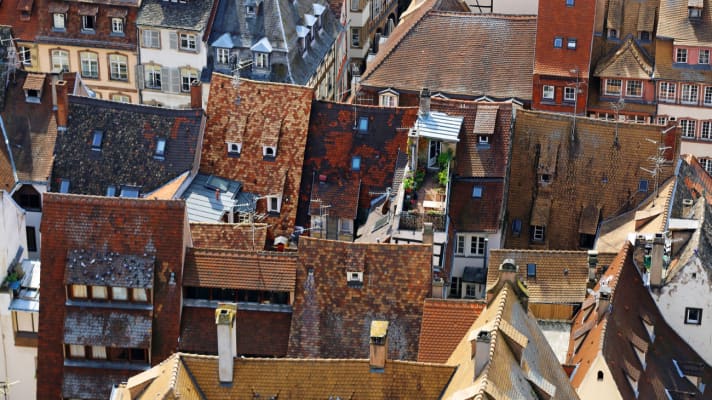
The following Tuesday is our Sunday: we sleep in today. Even though it gets warm very early and the floating lawnmower paddles through the harbour. However, it doesn't come into our corner at all, and so the thick, green carpet around our boat remains untouched. At thecapitainerie we are therefore assigned a new berth on the outer jetty, which is better than the old one in many respects. Luckily, the bow thruster is freeing itself as we move.
Then we tackle the tower of the cathedral, or rather its two towers: the ascent to the viewing platform is first made via the 330 steps of the spiral staircase in the unfinished south tower. Once at the top, there is an insight into the fire watch house. From up here, people used to keep an eye out for fires and other enemies. The large wheel was first used to haul up building materials and later supplies. Outside, carved graffiti from tourists from past centuries remind us of the past. They came from Gdansk, Riga, Rotterdam and the rest of the continent. On the rucksack of a girl who is deciphering the very artistic, stone calligraphy with her friends, the European stars shine in the shape of hearts. They are the visitors of today.
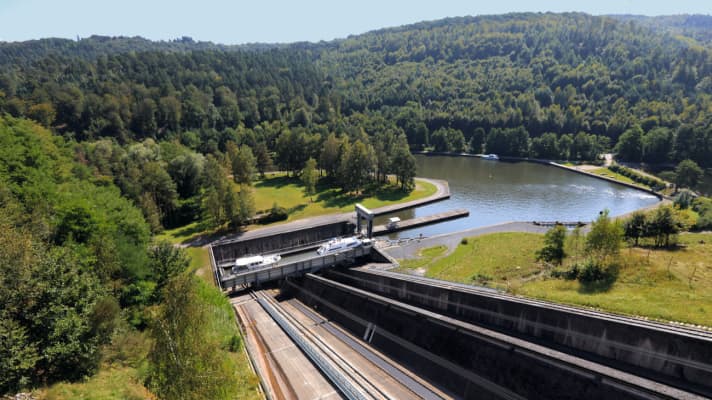
The way down leads through the north tower, the one with the spire. It had made Strasbourg Cathedral the tallest building in the world until the consecration of Hamburg's St Nicholas Church in 1874. This takes us from heaven back to earth and finally into the cathedral itself, an enormous hall, supported and traversed by Gothic arches, whose heights are lost in the dim light far above us. However, the lack of lighting has the advantage that the kings, emperors and saints on the slender stained-glass windows are illuminated by the sun in an unearthly blaze of colour.
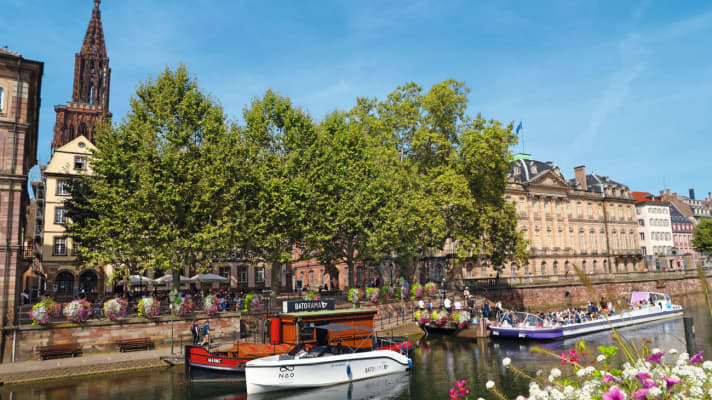
One last place is still missing in Strasbourg, another "border experience": the Rhine itself, for centuries a symbol of the rivalry and enmity between France and Germany. Only Europe managed to bridge this rift of the past through reconciliation - in the truest sense of the word: we are drawn through the modern part of Neudorf to the Jardin des Deux Rives, up to the bridge of the two banks. Between walkers, joggers and cyclists from both countries, here, in the middle of the river, there is not a single sign or line to indicate separation. The heart knows no borders.
Need more information? The travel report "Into the heart of Europe" can be found with further pictures, information on the area and a service section in BOOTE issue 02/2022 - from 12 January 2022 at newsagents or online in the Delius Klasing shop Delius Klasing Shop.

